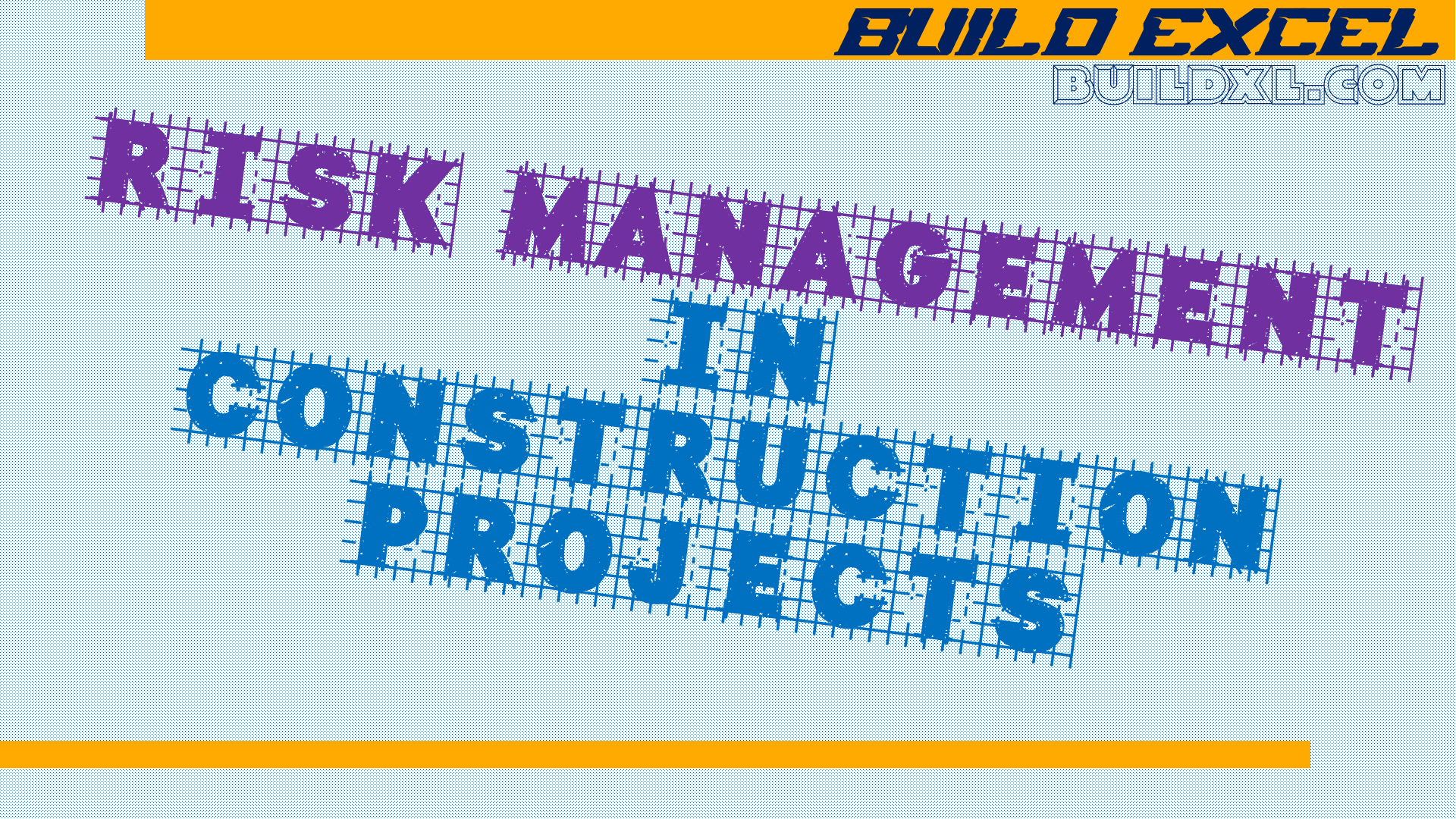In the dynamic and often unpredictable world of construction, managing risks is not just a necessity—it’s a critical component of project success. From the initial planning stages to the final delivery, construction projects are fraught with potential pitfalls that can lead to significant delays, cost overruns, and even project failure. Whether it’s financial uncertainties, safety hazards, or environmental challenges, each risk poses a threat to the smooth execution of a construction project.
Understanding the types of risks, how to identify them, and the strategies for managing them is essential for any construction professional aiming to deliver projects on time, within budget, and to the highest standards. In this article I’ll discuss the various aspects of risk management in construction, offering practical insights into the common risks you might face and the effective solutions to mitigate them.
From the importance of early risk identification to implementing a structured risk management process, and even preparing for specific risks with tailored solutions, this article provides a comprehensive overview that will equip you with the tools and knowledge necessary to navigate the complexities of construction projects.
Background
Definition and Importance:
Risk Management in Construction refers to the process of identifying, assessing, and mitigating risks that can impact the successful completion of a construction project. These risks can include financial uncertainties, legal liabilities, project delays, safety hazards, and environmental issues. Effective risk management is crucial because construction projects are often large-scale, complex, and involve numerous stakeholders. Without proper risk management, these projects are prone to cost overruns, delays, and even complete failure. By proactively managing risks, project managers can safeguard the project’s objectives, ensuring that it is completed on time, within budget, and to the required quality standards.
Current Trends/Challenges:
The construction industry is currently facing a range of challenges that make risk management more important than ever. Trends such as the adoption of new technologies, including Building Information Modeling (BIM) and digital project management tools, are transforming how risks are identified and managed. However, these advancements also introduce new risks related to cybersecurity and data management.
Additionally, challenges like supply chain disruptions, fluctuating material costs, and labor shortages have become more prevalent, especially in the wake of global events such as the COVID-19 pandemic. The increasing focus on sustainability and regulatory compliance adds another layer of complexity, requiring construction firms to adapt quickly to changing legal and environmental standards.
As the industry evolves, effective risk management must also adapt, leveraging new tools and strategies to address both traditional and emerging risks in construction projects.
Types of Risk in Construction Projects
Construction projects are inherently risky due to their complexity, scale, and the involvement of multiple stakeholders. The risks in construction can be broadly categorized into several types:
- Financial Risks: These include cost overruns, budget mismanagement, and unforeseen expenses. Financial risks can arise from inaccurate cost estimates, fluctuations in material prices, or delays that lead to additional costs.
- Legal Risks: Legal risks involve contract disputes, non-compliance with regulations, and liability issues. These risks often stem from poorly drafted contracts, changes in regulations, or legal actions taken by stakeholders.
- Safety Risks: Safety risks are among the most critical in construction, encompassing accidents, injuries, and health hazards on-site. These risks are heightened by inadequate safety measures, lack of training, or unsafe working conditions.
- Environmental Risks: Environmental risks include natural disasters, weather conditions, and environmental regulations. Such risks can delay projects, increase costs, or require changes to the project plan to comply with environmental laws.
- Technical Risks: Technical risks involve failures in design, engineering, or construction methodologies. These risks can result from using unproven technologies, errors in design, or inadequate quality control during construction.
Understanding the different types of risks in construction projects allows project managers to develop targeted strategies for mitigating these risks. By categorizing risks, managers can prioritize their response efforts, allocate resources more effectively, and implement specific measures to address the most critical risks. This proactive approach not only helps in preventing project delays and cost overruns but also enhances overall project safety and compliance. Ultimately, effective risk management leads to smoother project execution, improved stakeholder satisfaction, and greater financial stability for construction firms.
Identifying Construction Project Risks
Identifying risks in construction projects is the first and most crucial step in effective risk management. It involves systematically uncovering potential issues that could impact the project’s success. The identification process begins in the planning phase and continues throughout the project lifecycle. Key methods include:
- Brainstorming Sessions: Engaging project stakeholders in brainstorming sessions to identify risks based on their expertise and experience.
- Checklists: Utilizing standardized checklists that cover common risk areas in construction, such as safety, environmental concerns, and financial uncertainties.
- Historical Data Analysis: Analyzing past projects to identify risks that commonly occur and those that had significant impacts.
- Expert Interviews: Consulting with industry experts, such as engineers and project managers, who can provide insights into potential risks based on their specialized knowledge.
- SWOT Analysis: Conducting a SWOT (Strengths, Weaknesses, Opportunities, Threats) analysis to identify risks from both internal and external perspectives.
Accurately identifying risks in the early stages of a construction project allows for the development of comprehensive risk management strategies. This proactive approach reduces the likelihood of unexpected issues derailing the project and helps maintain project schedules and budgets. Additionally, early risk identification fosters better communication among stakeholders, as potential problems are highlighted and addressed collaboratively. Ultimately, identifying risks early enhances decision-making, improves resource allocation, and increases the likelihood of project success by minimizing disruptions and costly surprises.
Construction Risk Management Process
The construction risk management process systematically identifies, assesses, prioritizes, and mitigates risks throughout a project’s lifecycle. This approach helps manage potential issues proactively, reducing their impact. Here are the key steps in this process:
Risk Identification: Start by identifying all possible risks affecting the project. Use brainstorming, checklists, expert consultations, and historical data reviews to uncover potential issues.
Risk Assessment: After identifying risks, assess their likelihood and potential impact. You can use qualitative methods, like expert judgment, or quantitative methods, such as risk matrices and probability-impact assessments.
Risk Prioritization: Next, prioritize the risks based on their potential to disrupt the project. Focus on high-priority risks that are likely to occur and could significantly impact the project’s success.
Risk Mitigation: Develop specific strategies to address each prioritized risk. This may involve contingency planning, revising project schedules, securing additional resources, or implementing safety protocols.
Risk Monitoring and Control: Continuously monitor and control risks throughout the project. Conduct regular risk reviews, update the risk management plan as needed, and take corrective actions when new risks emerge or existing risks evolve.
Implementing a structured risk management process offers several benefits. It allows project managers to anticipate and prepare for potential issues, reducing the likelihood of unexpected disruptions. Effective risk management enhances decision-making by providing a clearer understanding of risks and the necessary mitigation steps. This leads to better project outcomes, including staying within budget, meeting deadlines, and ensuring quality standards. Additionally, by actively managing risks, construction firms demonstrate their commitment to delivering projects safely, efficiently, and with minimal surprises.
List of Common Risks and Sample Solutions
Construction projects face a wide range of risks that can jeopardize their success if not properly managed. Understanding these common risks is crucial for effective risk management. Below is a list of some of the most frequently encountered risks in construction projects, along with practical solutions to mitigate them:
- Cost Overruns: Unexpected increases in material costs, labor expenses, or changes in project scope can lead to budget overruns.
- Sample Solution: Implement strict cost control measures, use fixed-price contracts, and establish a contingency budget to cover unforeseen expenses.
- Delays: Project timelines can be affected by factors such as bad weather, equipment failures, or delays in material delivery.
- Sample Solution: Develop a detailed project schedule with buffer time for delays, use project management software to track progress, and have alternative suppliers or backup equipment available.
- Safety Incidents: Construction sites are prone to accidents and injuries, which can halt work and lead to legal and financial consequences.
- Sample Solution: Enforce rigorous safety protocols, provide regular safety training, and ensure that all workers have the necessary personal protective equipment (PPE).
- Regulatory Compliance: Failure to comply with local building codes, environmental regulations, or labor laws can result in fines, project shutdowns, or legal actions.
- Sample Solution: Conduct thorough legal reviews, stay updated on relevant regulations, and consult with legal experts during the planning and execution phases.
- Subcontractor Performance: Poor performance or failure of subcontractors can cause significant disruptions to the project’s progress.
- Sample Solution: Vet subcontractors carefully, use performance-based contracts, and maintain close communication with subcontractors to monitor their work quality and timelines.
- Environmental Risks: Construction projects can be impacted by environmental factors such as natural disasters, site contamination, or changes in environmental regulations.
- Sample Solution: Conduct environmental impact assessments, develop disaster response plans, and use sustainable building practices to minimize environmental impact.
Conclusion
Effective risk management is the cornerstone of successful construction project management. By understanding the common risks and proactively addressing them, you can significantly reduce the chances of unexpected setbacks and ensure your project’s success. Whether it’s through rigorous risk identification, strategic mitigation, or continuously monitoring risks throughout the project lifecycle, being prepared is key.
In an industry where even minor disruptions can have major consequences, the ability to manage risks effectively sets apart successful projects from those that fail. Remember, the goal isn’t just to avoid risks but to manage them in a way that optimizes project outcomes. As you move forward, consider integrating the strategies discussed in this article into your project management practices to enhance your ability to deliver projects that meet or exceed expectations.
Closing Thought: In construction, as in any complex endeavor, the difference between success and failure often lies in the details. By mastering risk management, you’re not just safeguarding your projects—you’re laying the foundation for a reputation of reliability, excellence, and leadership in the construction industry.
Further Reading
For those interested in deepening their understanding of risk management in construction projects, here are some additional resources that offer valuable insights and practical guidance:
- “Project Risk Management: A Practical Implementation Approach” by Michael Bissonette and Mike Bissonette,
- “ Risk and insurance in construction” by Nael G. Bunni,
- “A Guide to the Project Management Body of Knowledge (PMBOK Guide)” by PMI,
- “Managing Risk in Construction Projects” by Nigel J. Smith, Tony Merna, and Paul Jobling,
- Articles from the Project Management Institute (PMI),
- “Innovation, Strategy and Risk in Construction: Turning Serendipity into Capability” by Martin Loosemore.
These resources will help you expand your knowledge of construction risk management, offering both foundational theories and advanced strategies to apply in your projects.








Leave a Reply